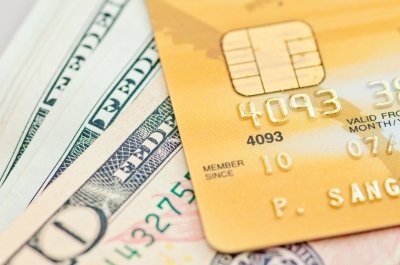If you have credit card debt, balance transfer credit cards are kind of an incredible option to help you. And odds are you probably know nothing about them…
How Balance Transfer Credit Cards Help:
First, think about the interest you’re paying on your credit card bill each month. The average American pays a little over 15% interest on their credit cards, where as bad credit or no credit consumers pay anywhere from 20% to 30% interest each month if they carry a balance.
So let’s say you have a $1,000 in credit debt, you make a $50 minimum payment each month and you pay 15% in interest. Assuming you’re making no new purchases and further adding to your debt, it will take you at least 23 months to pay off that debt and it will cost you nearly $160 dollars in interest to do so! ($157.94 if you want to be exact…)
By comparison, when you transfer that balance to a credit card with 0% interest during its intro period, you would pay $0 in interest and it would take you 20 months to pay off that debt at $50 a month. Unfortunately, the longest 0 interest credit card introductory periods clock in at 18 months so you would have to tweak those numbers slightly but, you get the idea…
If you’re paying the minimum on your credit card balance each month and getting seemingly nowhere because of interest, then it might be time to transfer that balance to a new card offering 0% APR on balance transfers during the intro period. You can save some serious cash while raising your credit score and establishing a good credit profile in the long run.
Here’s how to transfer your credit card balance…
Step 1 – Calculate How Long It Will Take You to Pay Your Debt:
If you’re hoping to pay down your entire debt with a 0% APR credit card, then you should first calculate your own payment plan; determine what you can afford to pay off each month, and be honest with yourself so that you’re calculating a realistic payback plan that will eventually get you to ZERO credit card debt.
Step 2 – Find a Balance Transfer Card That’s Right for You:
Once you figure out how long it will take to pay down your debt, then the next thing to do is to find and apply for a 0% interest credit card that applies to balance transfers. The longer you determine it will take to pay down your debt, the greater the intro period you should apply for. The good news is there are some excellent balance transfer credit cards available for consumers that have determined it could take up to 18 months to pay down their debt.
For example, the new Discover it Card – 18 Month Balance Transfer not only includes the longest intro period of any card on the market today, but it also comes with one of the very best rewards program available. Members can earn 5% cash back on up to $1,500 in purchases when they enroll in rotating categories that change each quarter, plus an unlimited 1% cash back on all other purchases.
Then again, if you’re more interested in consolidating your debt than anything else, a 0% card like the Citi Simplicity Card keeps spending, well, “simple”; no annual fees, no late fees and an 18-month intro period that applies to both purchases and balance transfers.
Remember, once a credit card is yours, it’s yours for good. You’ll want to be happy with your credit card long after the intro period expires, so make sure you’re applying for the right credit card for you over the long haul.
Step 3 – Initiate Your Balance Transfer:
Once you apply for and receive your new credit card, the next thing to do is to initiate your balance transfer.
This is done simply by contacting your new credit card company and telling them you’re interested in transferring your balance. You can do this online, by phone or via snail-mail; just remember that once the balance transfer takes place, it could take up to two weeks before your balance is cleared on your old card.
So if you’re paying off your entire debt, don’t forget any remaining payments you may have left on your old card. Also, don’t hesitate to transfer your balance since you’ll want to take advantage of as much of the intro period as possible. Plus, why wait to make another payment with interest?
Get that balance transferred as soon as you activate your card to rid yourself of interest fees. Finally…
Step 4 – Start Making On-Time Payments to Pay Down Your Debt:
You’re putting your 0% intro period eligibility – and your credit score – at serious risk if you start making late payments, or defaulting on them altogether.
Many credit cards require that cardholders make on-time payments to remain eligible for their 0% interest rates. And a good payment history is the number one factor FICO-makers Fair Isaac consider when calculating your credit score.
So if you plan on paying zero interest for as long as possible while maintaining a good-to-excellent credit score (the credit required to become eligible for the best balance transfer cards), then it’s imperative you make on-time payments on your new credit card.
Now that you know how much you can save by making a balance transfer and what kind of cards are available for such a transaction, it’s worth checking your own credit card account to determine whether or not a balance transfer is the right personal finance move for you.
(If you’re paying interest on your credit debt with no end in sight, then we’ll go ahead and say that it probably it is…)
Image courtesy of sixninepixels / FreeDigitalPhotos.net



When Greg and I started dating, he had about $2000 worth of credit card debt. I talked him into transferring it to a 0% card and he started paying it off fast. It worked great!
No wonder he saw a future with you! 🙂
I transferred to a 0% card when I was paying off my debt. The amount of money you can save plus the time you can potentially cut off from the repayments is well worth it in the long run.
I’d transfer the money to a 0% card as well if I had debt and the option is there. Any amount of money saved is money in our pockets. That’s a great breakdown for those that want to go that route as some have no idea what they should do.
Same here. I don’t have credit card debt, but if I did, I think this would be the way to go.
I agree….seems like a great idea if I still had credit cards 😉
I’ve used this method in the past to pay off debt. It works wonders in paying off your debt fast!
The only debt I had was my student loan debt so I couldn’t put it on a card, but if I did have credit card debt I’d absolutely transfer it to a 0% card. Gives you a little more time to pay the balance and you avoid the high interest rates.
I played the balance transfer game for 4 years while paying off my credit cards. It saved me a lot of money.
It’s worth the time to transfer to a 0% credit card, just don’t waste the opportunity to pay off the entire amount, otherwise you’ll be playing the 0% credit card game all your life. Something I learned the hard way.
I had a feeling that some people could get wrapped up in this trick more than once. Good point T!
We really should do this. It seems like every time we get an offer there’s some type of annual fee or something that detracts us. But we’ve gotta just sit down and crunch the numbers. Because I have a feeling we’re cheating ourselves out of a lot of cash.
If you’ve got the debt, then I’d say its definitely worth taking a hard look.
Very helpful post! This is what I would exactly do if ever I get into credit card debts. Thank God I am not into it.
I had credit card debt. Finally, I could manage to close it by using 0% balance transfer credit card. However, I agree that it is hard to refrain from purchasing while having that card.
For some people credit cards just don’t work and it is better just to stay away from them.
This is a very helpful post. A balance transfer is a good choice for saving more on interest if you plan on being discipline and not reusing the card. Thanks for sharing.